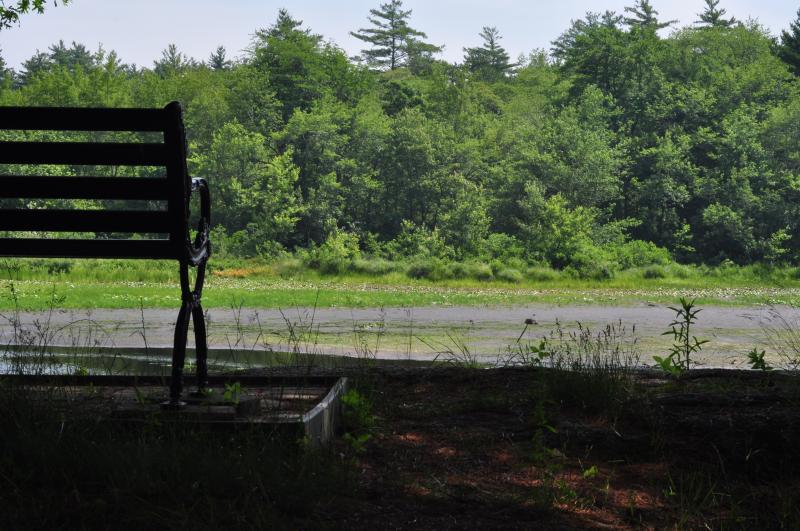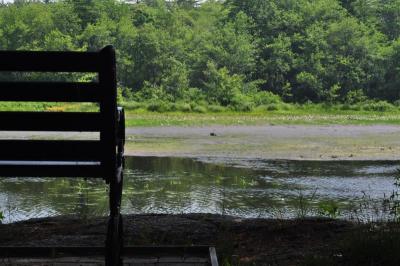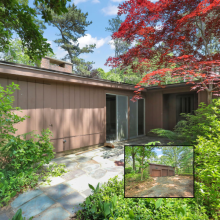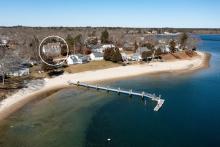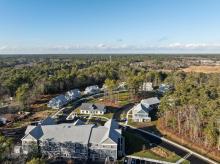Buzzards Bay Coalition to remove Hathaway Pond dam
The Pines at Hathaway Pond has recently found itself without a pond to be at.
And residents of the over-55 community aren’t very happy with the Buzzards Bay Coalition’s plans to permanently transform the 200-year-old pond back to its earlier life as a stream. Neither are nearby cranberry growers who have depended on the pond for generations.
The two groups have combined forces and locked horns with the New Bedford-based environmental group, which wants to destroy the pond-creating dam after the pond was temporarily drained for dam inspection. The Coalition has already spent considerable time and money in what its president describes as an effort to reclaim a vibrant natural ecosystem.
The fight has its roots back in 2008 when previous owner, Susan Hampson, was ordered by the Department of Recreation and Conservation’s Office of Dam Safety to bring the aging dam into compliance with dam safety regulations. The cost of doing so was prohibitive and Hampson began seeking buyers for her property and, after receiving an extension from the Office of Dam Safety, eventually sold the property in early May to the Buzzards Bay Coalition.
Since March 16 the water level in the pond has been reduced due to safety concerns surrounding the Hathaway Pond dam after Hampson had Wareham-based G.A.F. Engineering, Inc. evaluate the dam. It was recommend by G.A.F. that the pond remain at a lower level due to the degraded condition of the dam.
The coalition’s stated goal is to remove the dam at Hathaway Pond in order to restore the Sippican River to its natural state. The plans to remove the dam have been met with resistance from local residents and cranberry growers who use Hathaway Pond for recreation and agriculture.
“As a cranberry grower I’m very concerned about water supply,” said Woody Hartley of Hartley-Rhodes Inc., which owns several bogs connected to Hathaway Pond via groundwater. “We don’t draw any out and, in fact, we often put water in. But I’m worried that changing the water level in the pond will affect the groundwater levels I rely on.”
Hartley is also a partner in Hartley-Zell Development Corp., based in Middleboro, which developed the Pines at Hathaway Pond, an over-55 community abutting the now diminished pond.
“Cranberries require about 10 or 11 acre-feet of water per year,” said Doug Beaton, owner of Beaton’s Inc., a company with 50 acres of cranberry bogs off of Mary’s Pond Road in Rochester. Beaton has 140 acres in the area but his 50 lower acres concern him due to their reliance on water from Hathaway Pond.
“Cranberry growers feel confident with a nearby body of water,” said Beaton. When I bought this land I didn’t think this 35-acre reservoir might not be here one day.”
The coalition has expressed repeatedly that it will assist Beaton in finding an alternative to Hathaway Pond.
Beaton’s Inc. also has deeded water rights to the dam. “The Hiller family bought these bogs 80 years ago and made sure they received deeded water rights. It was that important to them,” Beaton said.
“The Office of Dam Safety has said the dam is unsafe and in extremely poor condition,” said Buzzards Bay Coalition President Mark Rasmussen. “Our study, by Inter-Fluve, showed that it would cost about $800,000 to repair the dam and about $200,000 to remove the dam.”
The Department of Conservation and Recreation Office of Dam Safety classifies the dam as a Class II Hazard Potential Dam. Class II Hazard Potential means the dam is unlikely to pose a major threat to people in the event of a total breach.
“Really, the state says this dam is unsafe because they have no evidence to think it isn’t,” said Beaton. “I have a friend who’s known this dam for 45 years and he says it’s the same as it’s always been. The state classified this dam as a hazard but it breached last year and almost nobody even noticed.”
A report dated 29 March 2011 by G.A.F. appeared to reassert Rasmussen’s claims regarding the dam. The G.A.F. report said stated three of the dam’s five sluiceways were eroded to a “very significant” extent and the other two sluiceways are significantly undermined. The report recommended leaving the pond at a lowered level due to the dam’s structural deficiencies.
On March 17, the Rochester Conservation Commission issued a Determination of Non-Applicability to Susan Hampson to temporarily reduce the water level in Hathaway Pond for the purposes of the G.A.F. study. The water level was not returned to its original level after the structural issues in the dam were found. The Buzzards Bay Coalition purchased the land from Hampson shortly after.
“Lowering the water level was done with the assistance of the coalition,” said State Representative Bill Straus who is attempting to establish a mediation process for all of the parties involved. “[The coalition] was intimately involved with lowering the water level.”
In a letter to the Rochester Conservation Commission dated 20 June 2011 the coalition explains that it has not refilled Hathaway Pond due to the safety concerns expressed by G.A.F. and that the coalition will seek the appropriate permits to remove the dam.
“The permitting process could take a while, probably around 12 to 18 months,” said Rasmussen.
“In my mind it is a fully functioning wetland that encompasses herring, agriculture and recreation,” said Straus. “A dam has been at this location since 1804 from what I’ve been told. In my mind the pond stays and the burden is on the coalition to show that this will improve conditions in the local environment.”
“The fish ladder that is part of the dam is poorly functioning,” said Rasmussen. “The pond habitat is shallow and low in nutrients. The dam causes water quality issues and removing the dam would make the entire system healthier.”
“They used the word 'stagnant' in some of their materials about the pond,” said Hartley. “This pond wasn’t stagnant. We had swans, pickerel, herring and other things.”
In its May newsletter the coalition stated, “Removal of the dam will have a variety of benefits including allowing river herring and other migratory fish to freely access the upstream habitat.”
“I’ve never seen it this bad,” said Dave Watling, the Rochester Herring Inspector of this year’s herring run. “Herring are tied to specific ponds when they come to spawn. If you take away Hathaway Pond then the herring who spawn there won’t just go somewhere else, I don’t know what will happen to them.” According to Watling, the herring were unable to access the water upstream from Hathaway Pond due to the reduced water levels.
To resolve the issue, Straus has proposed mediation between all of the affected parties through the Consensus Building Institute and Straus, the coalition, several abutters to the pond and others have contributed money to cover the mediation efforts.
“The mediation depends on the sincerity of all involved,” said Straus.
“’I’ve worked with the coalition before,” said Beaton. “I hope we can have a resolution, not a revolution.”
“We’ll work closely with Doug [Beaton] to help him find an alternative water source,” said Rasmussen. “That’s critical.”
“The coalition has done plenty of great work,” said Hartley. “But when it comes to this, they need to consider the whole situation. Just because there’s a dam here doesn’t mean you need to remove it.”
“Much depends on the coalition members and board making a judgment about what kind of neighbor they want to be in Rochester and Marion,” said Straus.
See our source documents and related information below.



